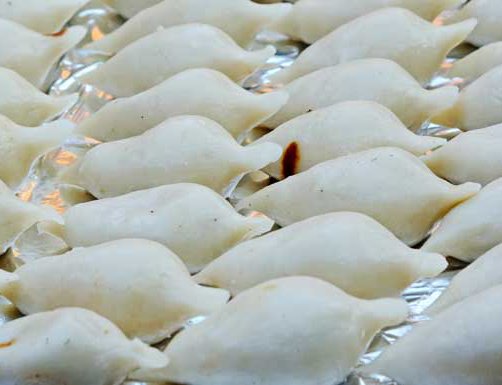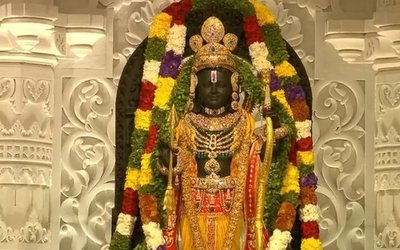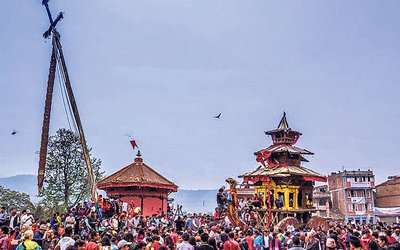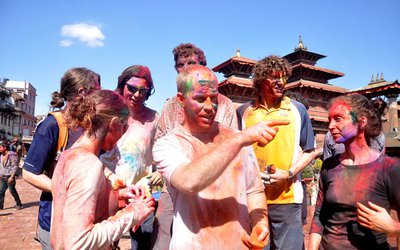
Given importance of the day, the government has announced a public holiday in the Kathmandu valley on Sunday, December 19, on the occasion of Yomari Punhi, Udhauli, Jyapu Diwas and Dhanya Purnima festivals, t
The Ministry of Home Affairs says communities celebrating these festivals will also get a public holiday outside Kathmandu also. Yomari Punhi falls in December/January. This season in Nepal is considered a winter season where the belief of locals says that Yomari gives a sweet taste and warmness to the human body to handle this bitter cold.
Whereas Yomari Punhi and Jyapu Diwas are celebrated by the Newa people, natives of Kathmandu, Udhauli is a big festival of the Kirant community. Many other communities also celebrate different festivals on this day in different ways.
Yomari Punhi is the festival celebrated by Newar communit marking the end of the rice harvest. It falls on November or December during the full moon day of Thinla, the second month in the lnar Nepal Era calendar.
The meaning of Yomari Punhi is full moon of yomari. Yomari is the delicious most popular Newari festivals and is observed every year during the full moon of December or November. Yomari is made from rice flour dough shaped like fish and filled with brown cane sugar and sesame seeds and finally steamed. On this day people worship to goddess of grains Annapurna for the rice harvest. It is believed that Yomari is originated from Newars of Panauti, Nepal.
Yomari Punhi is a classic food-oriented festival where the Yomaris are executed as an ideal dish.
When did Yomari Punhi fall?
Yomari refers to a portion of traditional Newari food that proportionally is filled with the sweetest fillings and Punhi, which means the full moon day. Cause, the festival occurs on the day of the full moon, the festival is called Yomari Punhi.
However, different communities call it uniquely as per their practice and written documents besides, the Yomari Punhi. Like, some call it Magra Sirsa Sukla Purnima for the reason of falling on the month of Mangsir of Nepalese Calendar ( most of the time).
Yomari Punhi; celebrating the harvest
Traditionally, people celebrate this festival to celebrate their harvest. That’s why, it is also called Dhanya Purnima where the deity of grains, Annapurna is worshipped.
At some other localities and distances, people worship Lord Ganesha, Laxmi, and the Kubera along with the mother goddess, Annapurna.
Moreover, the day used to be denoted as a traditional day for giving tenant farmers a share of the rice harvest to the owner of the land. But nowadays, they don’t wait up until Yomari Punhi.
Yomari Punhi, the classical way of fixing dates
This festival somewhere also touches the ancient way of experiencing love. There was a practice in the early days where the young boys fix their meeting or you can say dating with their loved one while entreating Yomari in the neighborhood.
You see, there was an austere society in the early era in Nepal. And, it hasn’t changed a little bit till today. Having a love affair somehow could cause a big fuss in a typical Nepalese family. Therefore, this event then was used to fix the meeting essentially where the young boys stroll around the houses of their loved ones.
Song dedicated to Yomari Punhi, Yomari Phonegu (Fonegu)
The word Yomari Phonegu means entreating the Yomari. While locals even call it Tyachim Taya Phonegu.
The act of entreating Yomari is more like the act done in Swanti (Deusi and Bhailo). The only difference that we found here is that the children wander home to home to collect Yomari in spite of Sel roti.
Children, running out from the home to collect Yomari under the light of the full moon, wearing fancy dresses and masks, singing one particular song and dance, then gathering at one pati (rest house) and start annotating about the collected Yomari (about its shape, fillings, and gestation) is a very rare scene to perceive, especially at this point of the century.
The song goes like this:
Tya chin Tya: wakachin tya;
(Blessings to both rich and poor)
Latapata Kulincha Jucha tya:
Blessings for both dull and clever)
Yomari chwamu; uki dune haku;
(Yomari is sharp and filled with black sweet)
Byu sa maaku, mabyu sa fakku:
(If you give it, it’s delicious, If you don’t, it’s not)
Byusa lyasse;
(If you give Yomari, you are beautiful)
Mabyusaa Buri Kuti:
(If you don’t, you are ugly)
Certainly and unfortunately, we are losing this kinda practice.
A little about the dish, Yomari
Yomari, delicious and conventional dishes of Newari courses seem not only a favorite of newa people but also of the others. Whoever for the first time taste it would definitely fall for it.
This delicious steamed dish somehow always managed to bring a big smile to your face. The Chaku, Khuwa, Sesame seeds, and the confection of rice flour, only with these manageable ingredients, one can prepare a delightful dish, Yomari.
The reason behind shaping Yomari into a fish or the domed shape, all have different meanings. While there are different perspectives on seeing the festival
Besides these two types of figures, people make several figures of the representative deities like Ganesha, Laxmi, Kubera, Nayo, and Bayo (eldest and the second eldest member of the family), etc.
Myths and stories about Yomari Punhi
There is a saying, saying that there is a story behind each monument, consequently the same goes for festivals too. There is one popular darn related to this festival which relates to one of the ancient, agricultural towns of Nepalmandal, Panauti. It used to call Panchal then.
The story here is referenced from the Yomari cartoon series.
In a meantime, one couple named Suchandra and Krita, like other farmers finished all their harvesting tasks after Mohani and Swanti. They were an ordinary couple but were extremely kind. One day, following their harvesting and threshing work, they decide to thank god and the goddess for blessing them with a good amount of grains.
So, they choose to worship on the upcoming full moon day. But, something strike on the mind of Suchandra that he call his wife and ask her to make a kind of unique dish from the fresh rice grain, this time.
Now, it was all up to Krita, what to make, and how to make it.
She was also no less than Suchandra, thus she accepted the challenge and went to the kitchen. She then prepared the flour of recently harvested rice and look for ingredients that she could use to make one novel dish.
There she found some molasses. She thought it would go well with the rice flour however she suddenly realized that it would be too cloying. So, she came up with another solution. Adding sesame seeds in it maintains the sweetness of the dish as well as adds an essence too.
Thereafter, she came with a unique dish from the kitchen, which was a sweet dumpling. Suchandra liked it so much that he wanted to share that dish with all his neighbors. So did he. Even, the neighbors liked it so much that they named it Yo;Mari. (Yomari means the favorite bread.)
The air of the story also tells that, on the same night, Kubera (the lord of wealth) visited them as a beggar. Cause they were so generous, they treat him as their guest and offer the Yomari. From this, Kubera got pleased and blessed them with more good fortunes and wealth.
He even declared that whoever prepares Yomari in the form of god and goddess on the full moon of thin la and observes four days of devotion to God will get rid of poverty and will acquire health, wealth, and prosperity. This is how the series of the festival started.
There is even a local song where the children or the young boys approach the Yomari givers as the beautiful ladies. (This kind of stuff like giving away the Yomari’s and all are done by the females of the family.)
Only in a few places, this act of giving Yomari is done.
Yomari Punhi is also called Thin la Punhi because of the very second month of the Nepal Sambat which is called thin la.
In the Jyapu, Awale, and Kumah tradition, a very important secret ritual, Gaidupuja is held on Yomari Punhi, annually.
During the festival, Brahmayani, Balkumari, Bhairab, and Nava Durga Jatra take place at Harishiddhi. With that, a kind of traditional dance, “Jala Pyakhan” is also observed there.
(Jala Pyakhan is observed only twice a year at Harishiddhi, once at Yomari Punhi, and the next one at Holi Punhi or Holi Purnima)
Yomari often is again eaten on the fourth following day after the Yomari Punhi as the Prasada. Till then, it is stored in a storeroom, under the paddy grains.
On the same day as Yomari Punhi, the married daughter is also welcomed for the feast. If she couldn’t make it on that day, the following day waits for her.
Based on the report in various portal
- Weather Forecast: Partly To Generally Cloudy Gandaki, Lumbini, Karnali And Sudur Pashchim Provinces
- Apr 18, 2024
- FNCCI President Dhakal Urges To Invest In Tourism Infrastructure
- Apr 17, 2024
- Halesi Mahadev Temple and Ram Nawami Festival
- Apr 17, 2024
- The Breakthrough Of The Nagdhunga Main Tunnel: Pride Of Country
- Apr 17, 2024
- Ram Nawami 2024: Importance And Significant For Hindus
- Apr 17, 2024
















